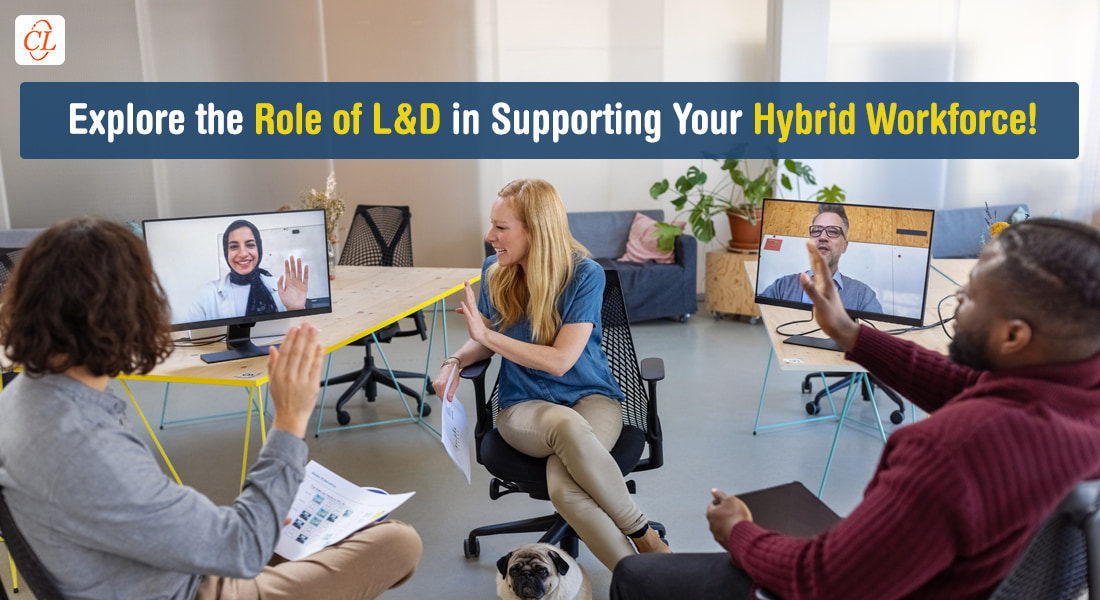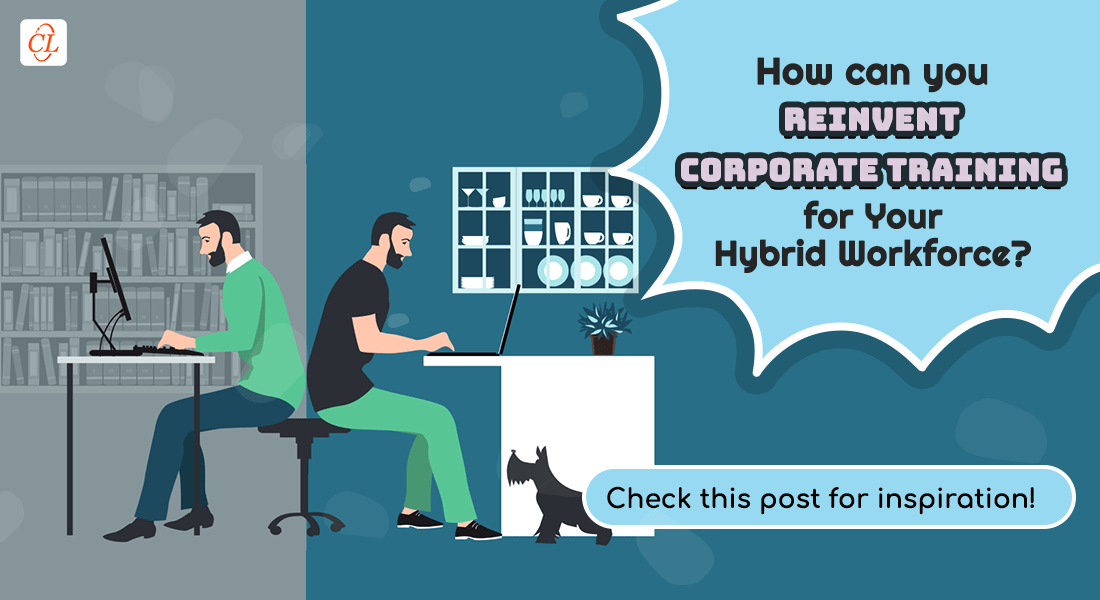6 Changes Organizations Must Deal With and How L&D Can Help?

Workspace learning is an inevitable part of every successful corporate training program. It is shaped by various real-time factors, such as technological advancements and a shift in priorities triggered by unpredictable catastrophes. Think of the ongoing pandemic. It taught us that to survive and thrive in calamities, we must adapt and grow. With the boom of remote workspaces and rapidly changing work environments, the old way of predicting skills required for unique roles at work aren’t valid anymore. L&D (learning and development) teams have to do things differently what with lockdowns and other Covid restrictions.
In this blog, we’ll look at how businesses are dealing with shifting workspace environments and how L&D can help.
What Are a Few Significant Changes in the Corporate Training Landscape?
Vital changes that organizations must deal with:
- The Emerging Hybrid workforce
- Employee wellbeing
- New technologies
- Changing processes and business models
- The Great Resignation
- New avenues for growth
6 Changes Organizations Must Deal with and How L&D Can Help?
1. The Emerging Hybrid Workforce
In recent years, nearly every company’s working style has changed substantially, with a major push toward remote employment. The pandemic changed our attitudes towards the emerging workspace and its environment, hastening the shift towards a remote and hybrid workforce.
According to recent PwC research, once the pandemic is over, most of the workforce (74%) said they would prefer to work remotely at least two days each week. Similarly, some businesses have had to look at flexible work arrangements to guarantee that employees return to office safely.
The road to a “hybrid workspace” has already begun. The idea is not wholly new but has gained a lot of traction thanks to COVID. Many employees now work remotely as well as in office, depending on their needs and job descriptions. This includes employees at major corporations such as Google and Citigroup.
How can L&D help:
- To build a hybrid workspace culture, L&D teams must integrate the flexibility of self-paced online training sessions with highly interactive live sessions.
- Learners already experience a lot of online interaction thanks to the development of social and collaborative learning technologies. When planning L&D sessions, training teams need to consider factors such as webinar fatigue, burdensome sessions, tight schedules, and expensive facilitator fees and arrangements.
- To build the ideal workspace for your hybrid workforce, evaluate the benefits and drawbacks of multiple strategies, such as VILT (Virtual Instructor-led Training), microlearning, mobile learning, and blended learning.
- Concentrate on training characteristics that learners desire such as: motivation, flexibility, engagement.
Get tips to excite and motivate learners in a Virtual Classroom.
2. Employee Wellbeing
Keeping employees happy seems like a sensible goal to strive toward in any situation, right? Despite the obvious answer, “employee welfare” has become one of the most common phrases used by HR teams worldwide. And it’s more complicated than that. When we consider how the pandemic has affected employees, any firm that wishes to remain sustainable and competitive must prioritize employee well-being.
How can L&D help:
- You can improve both the employees’ learning experience and social health by establishing opportunities for collaboration and providing technologies like a slack channel or the possibility to message colleagues during meetings. This allows workers to come together informally.
- You can also expedite a decrease in the skills gap by combining employees from diverse backgrounds and skill sets to work together on group projects during a session.
- Coaching people to develop resilience can help to minimize workplace stress and anxiety. You can run employee training in ways that increase staff productivity and retention.
- Employees are more productive when their employers encourage them to work on their mental health. Regular counselling and one-on-one sessions are the simplest method to establish a culture of open communication and employee confidence.
- You can use post-training questionnaires to get feedback on whether employees enjoy their training. These surveys can also help you find out if the session is too challenging, and what type of training they want in the future.
3. New Technologies
For the last several years, the drive for digital innovation in L&D has seen major highs and it’s gaining traction even as we speak. Owing to the pandemic, the way L&D teams handle changes in the workplace has driven many to use new tools and technology like virtual platforms and new ERPs. These tools help organizations adapt to the changing workspace dynamic as well as reinvent themselves by implementing increased digitalization.
The following are the two elements that are driving digital learning transformation:
- Increased investment in digital learning.
- Upheaval in the corporate world
How can L&D help:
- The digital transformation of L&D is much more than just embracing technology or investing in it. Instead, the digital revolution can only be effective when learners’ mindsets change, i.e., a culture shift that encourages continual learning facilitated by technology, and training programs that are consumed at any time and from anywhere.
- In business, staying on top of emerging changes is a smart habit to develop. Long-term success hinges on an organization’s capacity to overcome upheaval, which can range from revising business strategies, redistributing budgets, and changing how it conducts operations.
- The changes in work models requires the use of new technologies, such as virtual training tools, ERPs, and authoring tools that help put continual learning in place. Organizations must set up a sophisticated pedagogical framework that allows learners to access online learning and just-in-time performance support, at any time, and from any location.
- Companies must attempt to move away from traditional classroom instruction and instead move toward innovative modes, such as eLearning, mobile learning, microlearning, gamification, and VR enabled learning, among Incorporating these innovative techniques help in designing visually appealing and engaging training formats.
4. Changing Processes and Business Models
COVID-19 has a notably negative impact on firms that were heavily reliant on face-to-face or instructor-led training (ILT). Businesses must adapt new techniques to create effective training content. When procedures and business models changed over the last two years, organizations were unprepared for the unanticipated interruption to classroom sessions, the need to changeover to online learning, and the resulting challenges. They had to unlearn their outdated approaches and learn new ways of working overnight.
How can L&D help:
Even as organizations move toward working remotely, they cannot stop or postpone vital employee training. L&D executives must adopt new training tactics and set up virtual training sessions to sustain successful training. There is one takeaway from the current scenario, and it’s the need for future-proof training programs. The shift from in-person to online training is just the beginning. A lot more is involved when organizations go about establishing a new learning culture and future-proofing learning and development schemes.
- There was little time for training when firms allowed employees to work from home. Rapid eLearning has shown its usefulness by providing training at the speed of demand,. It reduces the time and cost of developing eLearning, making it a useful alternative to conventional corporate training.
- You can use simulations for learners to practice with, and replicate real life work-related circumstances. You can also use software tools and encourage experiential learning to meet learning outcomes. This way, you get your managers comfortable with digitalization and its application at work.
- You can use scenario-based learning to provide the opportunity to learn by doing. This enables learners to better relate to, assimilate, and remember knowledge for extended periods of time. For example, for compliance training, you can show the hazards that could develop if employees don’t apply the company’s code of conduct in specific circumstances at work.
- Learners can have a two-way, real-time conversation with instructors through virtual and interactive learning environments like(VILT. VILT combines technology-based solutions like Webex with the safety and comfort of being able to access it any time, and from any location. This allows learners to take part in synchronous, instructor-led sessions without needing to attend them in-person.
Here are some things to keep in mind when supporting uninterrupted training.
- Quick Adaptation from ILT to Virtual Training
- Easy Conversion from Flash to HTML5
- Swift Microlearning Asset Development
This way, you can introduce some much-needed changes to your ongoing employee training.
5. The Great Resignation
A major wave of resignations has occurred in recent years, particularly since the outbreak of the Covid-19 pandemic. The Great Resignation, as it is now known, has prompted almost 40 million individuals in the United States in 2021 to seek alternative employment. Some people wanted more perks and the ability to work from home, while others pursued self-employment.
Many people believe the pandemic is to blame for the recent wave of resignations. The fact is that COVID-19 was only a triggering event, not the cause of this mass wave of resignations. Things changed when employees left the office and entered remote seclusion. They were no longer ready to put their work ahead of their well-being.
How can L&D help:
- Organization’s must compensate their employees to keep them, because their employees could gain new skills from eLearning that could lead to promotion and increased compensation. Aside from that, eLearning must meet emerging demands of employees. There are those that prefer their smartphones, while others prefer to learn on a laptop. As a result, businesses must concentrate on personalizing the eLearning experience for each employee.
- A bad onboarding experience causes one out of every ten workers to quit a firm. During the Covid-19 pandemic, a multitude of employees moved to working remotely or in hybrid arrangements. You can build a course once and then reuse it as many times using eLearning. It’s better to have a single version of the onboarding training course rather than several instructors. If you haven’t already, now is the time to reevaluate your present onboarding approach and create a flexible and uniform eLearning strategy.
6. New Avenues for Growth
- Organizations are attempting to expand into new areas, products, services, and markets because of the pandemic’s impact on their traditional strongholds, and a decline in sales. A few organizations have also been merged or bought by larger corporations. This has led to a plethora of new regulations, workspace culture, change management, new business models, and new tools and technology all of which require customized employee training.
How can L&D help:
- Businesses create successful compliance training programsby developing custom blended learning courses. Posters and social media can help you market your training program, while quick videos and seminars can help learners grasp the benefits of training. You’ll need to employ instructor-led sessions, including narrative and video-based learning when developing training on new regulations at work.
- You must implement gamification through the LMS (learning management system) to create fun and engaging learning on workplace culture. It includes game-based mechanics, such as monitoring learners progress and promoting learner achievement by providing them with awards, badges, and certificates. You need to add elements, such as quizzes, to enhance your learners’ journey. eLearning developers need to redesign the entire learning curriculum as a gamified journey of information and skills acquisition.
- Make software training a priority, as organizations use computer technology in most if not all their operations. Look for skills gaps that might impede employee advancement. For example, train all your sales personnel on CRMs using simulation techniques and confirm that all project managers are familiar with software that allows them to exchange files and collaborate easily.
- When there is no traditional learning program available, employees might benefit from microlearning’s bite-sized content. You can create animations, quizzes, and digital flip cards, for example, to help workers adapt to rapid technological and operational changes while also creating avenues for continual learning.
- Even the most devoted instructor might find it difficult to keep up with current developments in eLearning. However, eLearning is shifting toward more inclusive and collaborative technologies. Current digital training trends are likewise headed toward more engaging and exciting formats, relying heavily on new age tactics like augmented reality, virtual reality and gamification to capture and absorb learners’ attention.
Parting Thoughts!
Are you a learning and development enthusiast who wants to stay on top of the newest developments in both the business and training worlds? And do you want to improve your training by incorporating ideas from many disciplines and sectors? If this is you, then you need to build and expand your network by meeting peers and practitioners from major global organizations? Look no further! LearnFlux is here for you!
Engage in exciting training sessions, workshops, pop quizzes, and more! You’ll find all these only on LearnFlux, an upcoming webinar and a collaborative network for L&D professionals, that’s run by L&D professionals. Join us today by clicking the box below.





